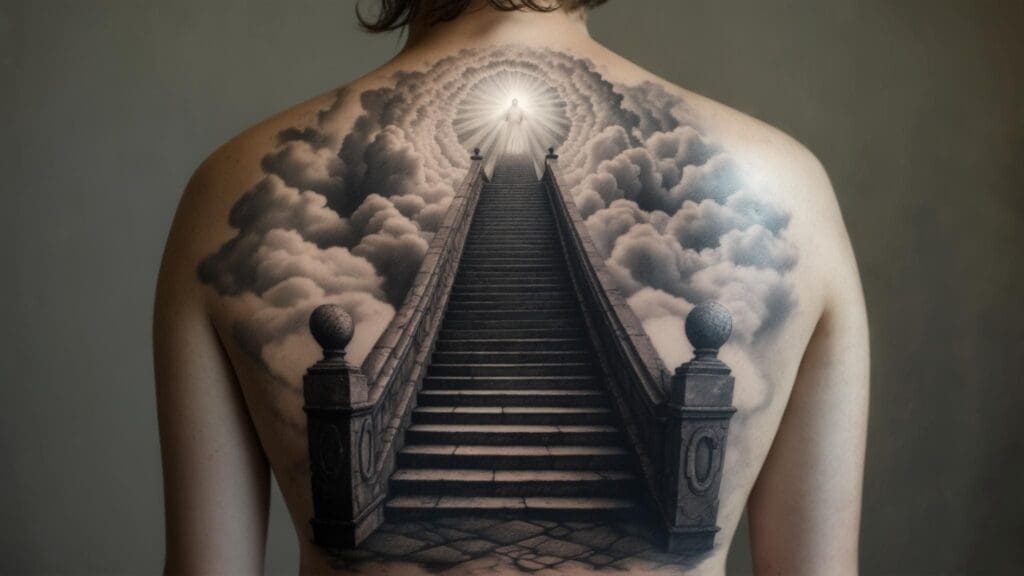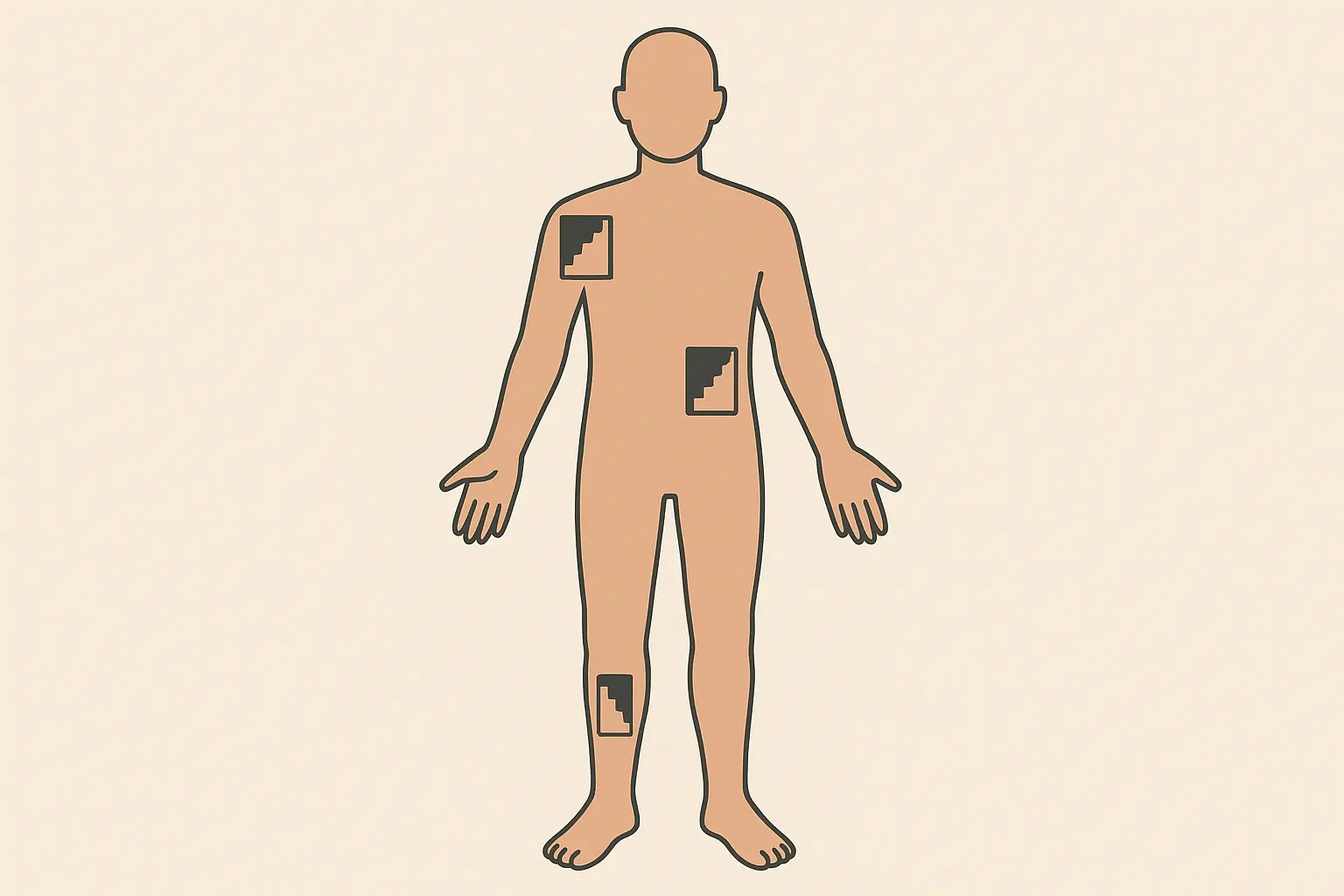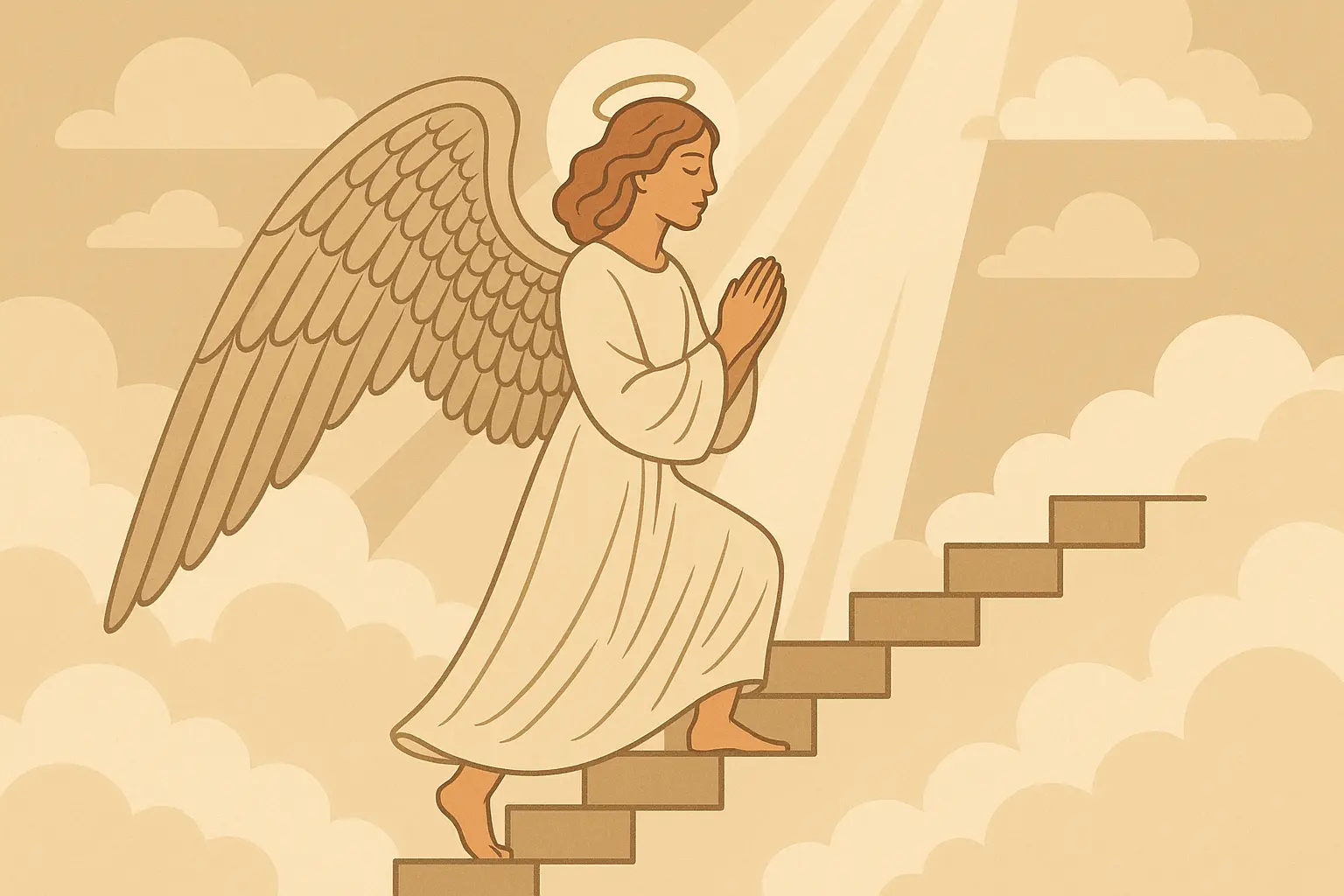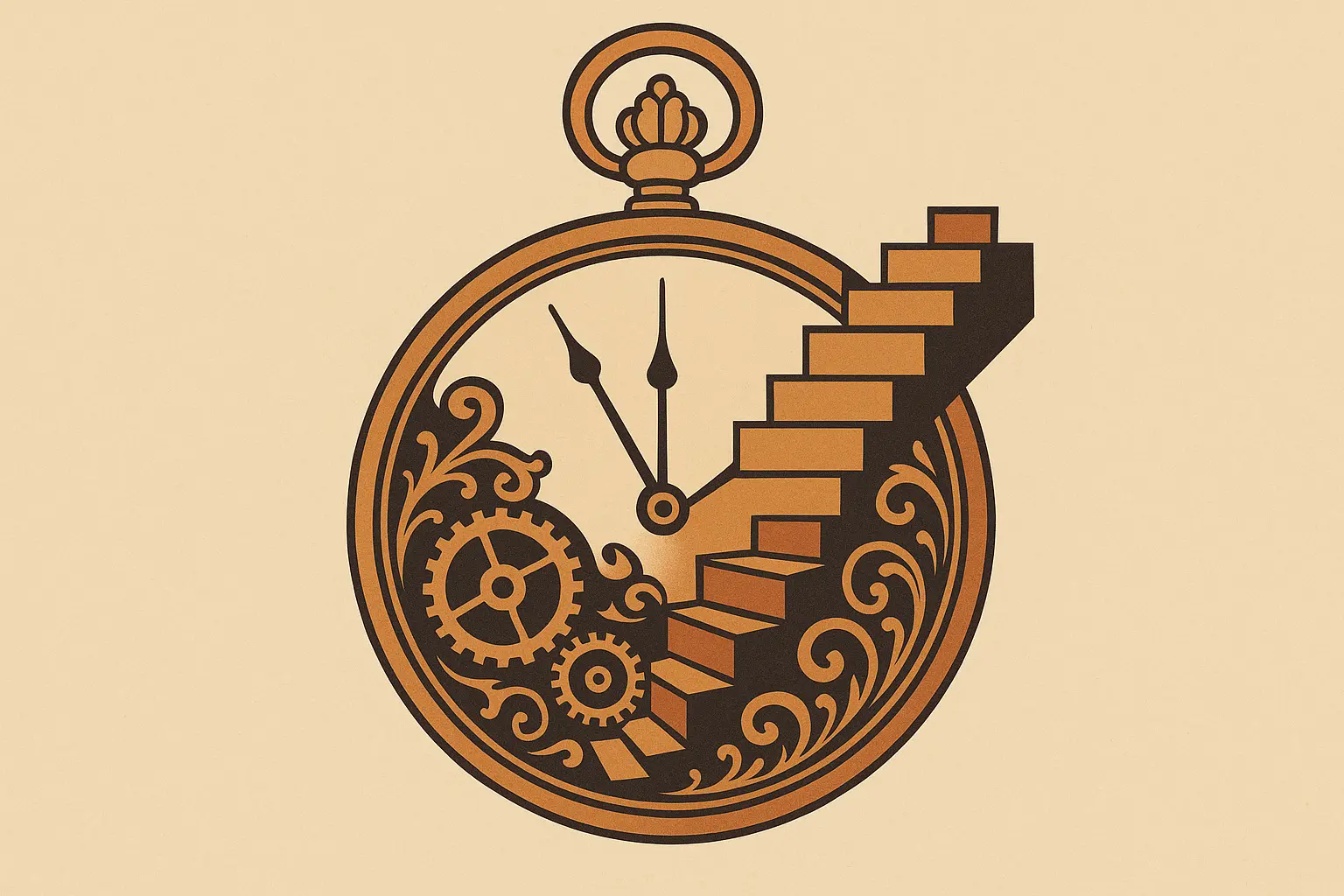25 Stunning Stairway to Heaven Tattoo Ideas That Will Transform Your Spiritual Journey

I’ll be honest – when I first walked into a tattoo shop thinking about a stairway to heaven design, I was completely overwhelmed. There were so many options, and I had no idea what would actually work on my body or fit my budget. Then I saw this beautifully crafted stairway ascending through clouds on the artist’s portfolio wall, and something just clicked. The symbolism spoke to me on a level that simple decorative designs couldn’t match.
If you’re considering one of these tattoos, you’re probably dealing with something pretty meaningful – maybe you lost someone important, or you’re going through a spiritual phase in your life. These aren’t just pretty pictures; they usually mean something deep. Stairway to heaven tattoos represent hope, spiritual growth, and that journey toward something bigger than ourselves. Whether you’re honoring someone who passed away, expressing your faith, or marking a major life change, these designs pack serious emotional punch.
Look, there’s a lot to think about before you commit to something this permanent and potentially expensive. I’ve put together 25 different approaches across six main styles, from traditional religious stuff to modern artistic takes. Some are simple and affordable, others are complex masterpieces that’ll cost you serious money. The key is finding something that actually fits your story, your budget, and your lifestyle.
What You Need to Think About First
Before you start scrolling through design ideas, let’s get real about what you’re signing up for. These tattoos can range from a quick afternoon session to months of work, depending on what you want. And trust me, the decisions you make now will affect how happy you are with this thing for the next 20+ years.
How Detailed Do You Actually Want This Thing?
Simple line work is your friend if you want something clean that won’t break the bank. We’re talking basic stairs, maybe some clouds, done in clean black lines. It ages great, looks professional, and you can get it done in one session. Perfect if you work in a conservative office or just prefer subtle tattoos.
But if you want something that stops people in their tracks – detailed stone textures, realistic clouds, ornate gates – you’re looking at a whole different ballgame. We’re talking multiple sessions, serious money, and you better make sure your artist actually knows how to do architectural details. I’ve seen too many “detailed” stairway tattoos that look like a kid drew them.
Here’s the reality check: A detailed portrait of grandma on those stairs? You’re looking at probably 6+ sessions and a lot of money. A simple line drawing? Maybe 2-3 hours total. Be realistic about what you can handle, both pain-wise and financially.
Understanding the pain level tattoo chart becomes crucial when you’re planning something that might take 15+ hours across multiple sessions.
|
How Complex? |
Time Needed |
What to Expect |
How It Ages |
Work-Friendly? |
|---|---|---|---|---|
|
Simple Lines |
2-4 hours |
Clean, basic shapes |
Great (15-20 years) |
Very – subtle design |
|
Some Detail |
6-10 hours |
Shading, basic architecture |
Pretty good (10-15 years) |
Depends where you put it |
|
Full Detail |
15-25+ hours |
Everything – portraits, textures |
Needs touch-ups (8-12 years) |
Probably not |
Where Are You Putting This Thing?
The cool thing about stairway designs is they naturally work with your body’s lines. A stairway going up your spine or ribs follows your natural shape. But placement affects everything – how much it hurts, how much detail you can fit, and whether your boss is going to see it every day.
A back piece gives you the most room to work with. You can fit all the architectural details, memorial elements, whatever you want. But it’s also the most expensive and time-consuming option. A forearm piece is way more visible – great if you want to show it off, not so great if you work somewhere conservative.
Think about your actual life. If you’re a teacher, that full-sleeve stairway might cause problems. If you work in tech or creative fields, you probably have more freedom. And consider the future – what if you change careers?
Sarah, who works in healthcare administration, went with a simple geometric stairway on her inner forearm. She can cover it with long sleeves for board meetings but show it off when she wants to. Smart thinking.
What’s This Actually Going to Mean to You?
This is where people mess up. They see a cool design online and think “that looks awesome” without really thinking about the meaning. Memorial tattoos especially need careful thought. Are you getting this because you’re still in the thick of grief, or because you’ve processed the loss and want to honor someone’s memory?
I’ve met people who got elaborate memorial pieces right after losing someone, then regretted parts of the design later when their grief evolved. Not saying don’t do it, just make sure you’re in the right headspace.
Religious imagery is another big one. If you’re going through a spiritual phase, that’s fine, but what if your beliefs change? A huge Christian stairway might not feel right in 10 years if you’re no longer practicing.
Let’s Talk Money Because Nobody Else Will
A small, simple stairway might run you $200-400. Something detailed covering your whole back? You’re looking at $2000-5000+, and that’s if you find a good artist who doesn’t charge premium rates.
But here’s what most people don’t think about – maintenance. Those detailed pieces with fine lines and shading? They’re going to need touch-ups every 8-12 years to keep looking good. Budget for that.
And please, save up enough money to get it done right the first time. I’ve seen too many people go cheap, get a mediocre tattoo, then spend even more money trying to fix it later.
Traditional and Religious Stairway Designs
If you’re drawn to classic religious imagery, these designs offer that timeless spiritual feel. But let’s be real – they’re not for everyone, and they definitely make a statement about your beliefs. Make sure that’s actually where you’re at spiritually.
1. Classic Stone Staircase with Pearly Gates
Picture the classic idea of heaven’s gates – stone steps going up through clouds to those pearly gates you’ve seen in movies. It’s pretty traditional Christian imagery, so make sure that fits with your beliefs.
The tricky part is finding an artist who can actually pull off the architectural details. Those gates need to look like actual metalwork, not cartoon squiggles. The stone steps should have individual character – weathering, cracks, texture. This isn’t a tattoo for beginners.
You’ll need at least 8-12 inches of height to make this work properly, which means back, ribcage, or maybe a large thigh piece. And plan on multiple sessions – there’s just too much detail to bang out in one sitting.
Real talk: This takes serious time and money, needs an artist who specializes in architectural work, and makes a pretty obvious statement about your faith. Great if that’s authentically you, but don’t get it just because it looks cool.
2. Biblical Jacob’s Ladder with Angels
This one comes straight from Genesis 28:12 – the ladder with angels going up and down between earth and heaven. It’s got serious biblical weight, so again, make sure this actually connects with your faith.
The angels can be climbing, flying, whatever feels right. The ladder might be wood with rope, or stone steps, or something more abstract. Traditional tattoo styling with bold lines ages really well and gives you that classic look.
Michael, a seminary student, worked with his artist to include Hebrew text along the ladder sides and designed the angels to reflect his Eastern Orthodox background. That’s the kind of personal touch that makes these tattoos meaningful instead of just generic religious imagery.
Consider this if: You have genuine biblical connection, appreciate traditional tattoo styles, want something with clear spiritual meaning.
3. Gothic Cathedral Steps with Rose Windows
Medieval church architecture – stone steps leading to a cathedral with those intricate circular windows and flying buttresses. It’s dramatic and impressive, but definitely appeals to specific tastes.
The rose windows are incredibly detailed work. If your artist can’t handle intricate geometric patterns, this is going to look terrible. Same with the gothic architecture – it needs to look authentic, not like a Halloween decoration.
This one’s for people who genuinely appreciate medieval religious art and architecture. It’s not a casual choice.
4. Rustic Wooden Stairs in Forest Setting
Weathered wooden steps winding through a mystical forest toward bright light. This appeals to people who find their spirituality in nature rather than traditional churches.
The wood texture work showing age and weather damage can be really beautiful. Add some moss, twisted branches, dappled sunlight filtering through leaves. This works great for outdoor enthusiasts who connect with nature spirituality.
Perfect for: Nature lovers, people who find God outdoors, those wanting spiritual symbolism without obvious religious imagery.
5. Ancient Temple Steps with Sacred Geometry
Classical temple architecture mixed with geometric patterns and universal spiritual symbols. Think Greek or Roman columns with mandala patterns, golden ratio proportions, maybe some chakra symbols worked in.
The mathematical precision creates designs that age really well – geometric elements stay sharp longer than organic shapes. Plus it appeals to people interested in universal spiritual principles rather than specific religions.
Good choice if: You’re into ancient wisdom traditions, prefer mathematical/geometric aesthetics, want something that transcends specific religions.
Memorial and Remembrance Stairway Tattoos
These are probably the most emotionally heavy designs on the list. They’re deeply personal and usually incredibly meaningful to the people who get them. But they also require some serious emotional readiness.
6. Stairway with Portrait and Dates
A loved one’s portrait at the top of the stairs, surrounded by clouds or divine light. Birth and death dates worked into the steps or floating on banners.
Here’s the thing about portrait work – it requires exceptional artistic skill. Bad portrait tattoos are really, really bad. You need high-resolution reference photos and an artist who specializes in realistic faces. Don’t compromise on this.
The emotional weight of these pieces is intense. Some people find the process healing, others find it overwhelming. Make sure you’re mentally ready for hours of tattooing while looking at a permanent memorial to someone you’ve lost.
Only consider this if: You’re emotionally ready for the permanence, have excellent reference photos, can afford an artist who specializes in portraits.
7. Paw Print Steps Leading to Rainbow Bridge
For pet memorials – paw prints creating the steps leading to the rainbow bridge. The pet’s name and dates, maybe some breed-specific details or favorite toys.
The rainbow bridge concept is widely understood in pet communities and provides comfort during grief. You can vary the paw print sizes for different life stages or multiple pets in one design.
This one hits different if you’ve lost a beloved pet. The rainbow bridge symbolism really helps with the grieving process.
8. Military Memorial with Dog Tags and Flag
Honoring fallen service members with steps leading to folded flags, dog tags, or military symbols. Unit insignia, rank symbols, meaningful military quotes.
The folded flag needs to follow proper military protocol – this isn’t something to wing. Dog tags need careful lettering work. Military families and veterans really appreciate when these details are done respectfully.
Important: Strong military connection required. Don’t get military imagery if you haven’t earned it or aren’t honoring someone who did.
9. Childhood Memory Staircase
Steps made from childhood elements – toy blocks, storybooks, playground equipment. Each step representing different ages or interests.
Toy blocks can spell out names, storybook spines show favorite tales, playground elements add whimsical touches. This works for honoring young lives or celebrating cherished childhood memories.
Deeply personal symbolism that requires careful element selection to ensure lasting meaning.
Angel and Guardian-Themed Designs
Angel themes offer spiritual symbolism with broader appeal than strictly religious imagery. The protective symbolism resonates across different belief systems and provides ongoing comfort.
10. Guardian Angel on Stairway
A protective angel guiding someone up the stairs or standing at the top as a welcoming presence. Wings can be detailed with individual feathers or stylized depending on your preference.
The angel’s expression and pose matter a lot – protective, welcoming, guiding, comforting. Flowing robes, halos, divine light add traditional elements while keeping artistic flexibility.
Those interested in angel symbolism might want to check out 25 powerful angel tattoo ideas for men for additional protective and spiritual themes.
Works well for: Believers across denominations, people wanting protective symbolism, those comfortable with larger pieces for proper detail.
11. Angel Wings Forming the Stairway
Creative take where large angel wings create the actual steps – detailed feathers suggesting ascending levels instead of traditional stairs.
Each feather needs individual attention for realistic texture. The wing structure needs anatomical accuracy while serving as functional steps. Color gradients from darker base feathers to lighter tips enhance the ascending motion.
Unique artistic approach that sets your design apart from traditional stairs, flows excellently with body anatomy.
12. Multiple Angels Ascending Together
Several angels in different poses climbing or floating along the stairway. Each angel can have different characteristics representing different spiritual aspects or departed loved ones.
Complex composition that requires careful planning to avoid overcrowding. Different wing positions, flowing garments, varied poses create dynamic movement. These complex pieces require exceptional artistic skills.
Consider if: You want rich symbolic meaning, can afford advanced artistic skills, have space for larger back or ribcage piece.
13. Angel and Mortal Hand-in-Hand
An angel guiding a human figure up the stairway – divine guidance and spiritual support. The human can be generic or personalized to represent you or a loved one.
The interaction between figures requires exceptional skill in proportion and emotional expression. The angel typically appears larger or more luminous, while the human shows vulnerability or trust. Deeply personal symbolism about divine support through life’s challenges.
Dual figure work requires exceptional artistic skill and works best in larger formats for proper detail.
Modern and Artistic Stairway Interpretations
If traditional religious imagery doesn’t speak to you, modern interpretations offer contemporary approaches while keeping the spiritual symbolism. These often age better and work well in professional settings.
14. Geometric Stairway with Sacred Patterns
Stairs built from geometric shapes, triangles, or sacred geometry patterns. Clean lines and precise angles appeal to modern tastes while incorporating ancient mathematical principles.
Fibonacci spirals, golden ratio proportions, mandala patterns can be worked into the step construction. Mathematical precision creates designs that age exceptionally well due to bold lines and geometric accuracy.
Perfect for: Contemporary art enthusiasts, people preferring symbolic over literal representation, those wanting longevity in their body art.
15. Watercolor Stairway with Flowing Colors
Watercolor techniques create stairs that look painted with flowing, blended colors. Emphasizes emotional expression over realistic representation.
Color selection is crucial for both immediate impact and aging. Watercolor techniques require specialized skills and may soften over time, but create unique artistic statements.
Appeals to creative personalities wanting unique expression, but requires specialized artist skills and may need touch-ups sooner.
16. Minimalist Line Art Stairway
Simple, clean line work – minimal detail but maximum visual impact through precise execution. Perfect for professional environments or understated personal expression.
The minimalist approach demands exceptional line work precision since there’s nowhere to hide mistakes. Each line must be perfectly placed and weighted.
Alex, a software developer, chose a single-line geometric stairway spiraling up their forearm. The design uses mathematical precision with each step forming part of a Fibonacci sequence, reflecting both their technical background and spiritual beliefs. The minimalist approach works perfectly in their tech startup environment.
Great for: Professional settings, smaller placements, people preferring understated designs, excellent aging characteristics.
17. Surreal Floating Steps
Stairs that appear to float in space without visible support, creating dreamlike or impossible architecture reminiscent of M.C. Escher’s mathematical art. The surreal quality appeals to those seeking unique conversation pieces.
Impossible architecture requires creative artistic vision and careful planning to maintain visual coherence while defying physical laws. Shadow work and perspective manipulation create the floating illusion effectively.
Surreal approach appeals to artistic personalities and creative thinkers, requires creative vision, unique conversation starter.
Clock and Time-Based Stairway Concepts
These designs add philosophical depth about time’s role in spiritual journeys. They’re great conversation starters and work well for people contemplating life’s temporal nature.
18. Clock Face Steps with Roman Numerals
Clock elements worked into the stairway – Roman numerals on steps, clock faces, mechanical components like gears and pendulums. The time symbolism adds depth about life’s passage.
Roman numerals on individual steps can represent significant life moments. Clock faces might show meaningful times like birth or departure moments. Mechanical elements create steampunk aesthetic appeal.
Time symbolism appeals to those contemplating mortality, requires detailed mechanical illustration, works well as philosophical conversation piece.
19. Hourglass Sand Forming Stairway
Sand falling from an hourglass creates individual steps – representing time running out or the transition between life and death. The flowing sand creates beautiful movement and powerful symbolism.
The sand flow requires skilled execution to appear natural and dynamic. Individual sand grains might be visible in detailed work while the hourglass provides strong compositional framing.
Unique artistic concept, requires skilled particle dynamics understanding, powerful mortality symbolism.
20. Pocket Watch with Chain as Stairway Rail
Antique pocket watch with its chain forming a handrail along the stairway. Combines vintage aesthetics with functional design elements.
Detailed watch face work requires precision in numbers, hands, and mechanical elements. Chain links need individual attention for realistic metalwork appearance. Appeals to vintage aesthetic enthusiasts.
Vintage appeal for classic tattoo lovers, requires precision work, can include personally significant time display.
21. Calendar Pages as Individual Steps
Each step represents a calendar page or specific date – highly personal timeline visualizations showing significant life dates, countdowns, or memorial progressions.
Date selection requires careful planning for lasting significance. Text-heavy designs need skilled lettering and font selection that remains readable as the tattoo ages.
Highly personal date selection creates deep meaning, requires planning of significant dates, text needs skilled lettering.
Nature and Landscape-Integrated Designs
For people who find their spirituality in natural settings rather than churches, these designs combine spiritual symbolism with environmental elements.
22. Mountain Path Stairway with Sunrise
Natural mountain scenery with constructed stairs winding up mountainsides toward brilliant sunrise. Realistic landscape elements like rocks, trees, distant peaks.
Sunrise symbolism represents hope, new beginnings, spiritual awakening. Mountain setting suggests challenge, perseverance, achievement. Atmospheric perspective creates depth and visual interest.
Appeals to outdoor enthusiasts and hikers, requires skilled environmental illustration, sunrise represents hope and new beginnings.
23. Stairway Through Seasons
Stairs passing through different seasonal landscapes – spring flowers at bottom, summer greenery in middle, autumn colors higher up, winter snow at summit. Represents life’s cycles.
Each seasonal section requires different artistic techniques and color palettes. Spring features delicate flowers, autumn demands skilled leaf gradients, winter needs snow texture work.
Those interested in seasonal symbolism might explore stunning flower tattoo designs to understand how natural elements enhance spiritual themes.
Complex seasonal illustration requires diverse skills, rich life cycle symbolism, appeals to those seeing life as cyclical journey.
24. Ocean Waves as Stairway Steps
Ocean waves creating stepping patterns with each crest forming a step toward distant horizons. Lighthouses, ships, or seabirds for additional maritime symbolism.
Wave motion requires skilled water illustration showing proper foam patterns, physics, and light reflection. Ocean setting suggests life’s ebb and flow, emotional depths, spiritual cleansing.
Fluid wave motion needs skilled water illustration, appeals to water lovers and coastal residents, unique artistic interpretation.
25. Tree Branches Forming Natural Stairway
Intertwining tree branches creating natural stairways leading up through forest canopies toward light filtering through leaves. Organic growth patterns emphasize natural spirituality.
Branch structure requires botanical accuracy while serving stepping purposes. Leaf work, bark textures, light filtering effects create realistic forest environments celebrating natural spiritual connections.
Organic design flows well with body contours, tree symbolism represents growth and life, appeals to environmental consciousness.
What Actually Works Best for Different People
Let’s be honest about which designs perform best in real life. Some look amazing on Pinterest but don’t translate well to skin, while others might seem simple but actually age beautifully.
Traditional religious designs work great if you have strong, stable faith connections. The architectural elements age well when done right, but they make obvious statements about your beliefs. Professional visibility might be an issue in some fields.
Memorial pieces score highest for personal meaning – they’re virtually guaranteed to remain significant regardless of changing tastes. Portrait work requires exceptional artists and may need touch-ups, but the emotional value usually outweighs technical concerns.
Modern geometric versions provide the best aging characteristics due to mathematical precision and bold lines. They work well in professional settings and appeal to contemporary tastes, though they might feel less emotionally resonant than figurative approaches.
Angel themes offer spiritual symbolism with broader appeal than denominational imagery. The protective symbolism works across belief systems, though they typically need larger placements for proper detail.
Nature themes score highly for universal appeal and work excellently for non-religious spirituality. They require skilled landscape illustration but generally age well with proper execution.
Matching This to Your Actual Life
What if your boss sees it? Minimalist and geometric versions offer maximum professional flexibility through subtle symbolism that doesn’t immediately scream “religious tattoo.” Traditional religious designs might need strategic placement in conservative environments.
Memorial pieces often hold such profound significance that professional concerns become secondary. But thoughtful placement still lets you control visibility levels.
Will this hurt your chances of getting hired? Depends on your field. Tech and creative industries usually don’t care. Healthcare, education, and corporate environments might. Plan accordingly.
What if you change your mind about religion later? This is real. Some people get elaborate Christian imagery during spiritual phases, then feel weird about it years later when their beliefs evolve. Choose imagery that reflects stable, long-term spiritual connections rather than temporary enthusiasm.
Your family thinks tattoos are trashy – how do you deal with that? That’s between you and them, but remember you’ll be living with this decision longer than their opinions matter. Get it for you, not to rebel or conform.
Real Budget Talk
Small, simple stairway: $200-400
Moderate detail, medium size: $800-1500
Large detailed back piece: $2000-5000+
Portrait memorial work: $1500-3000+
Don’t forget maintenance costs. Detailed pieces need touch-ups every 8-12 years. Watercolor elements might need refreshing every 5-8 years. Simple geometric work can go 15-20 years looking great.
Save up enough to get it done right the first time. Cheap tattoos aren’t good, and good tattoos aren’t cheap. I’ve seen people spend more money trying to fix bad work than they would have spent getting quality work initially.
Finding the Right Artist
Don’t just pick someone because they’re cheap or close to your house. Look at their Instagram – do they actually do this style well? Have they done stairway tattoos before? Can they draw realistic clouds that don’t look like cotton balls?
For memorial portraits, only work with artists who specialize in realistic human faces. Bad portrait tattoos are heartbreaking when they’re honoring someone you loved.
Religious imagery requires cultural sensitivity and understanding. Make sure your artist respects the spiritual significance and isn’t just copying designs without understanding their meaning.
Understanding how much tattoos cost helps you budget properly for complex stairway designs, while exploring spiritual tattoo ideas provides additional meaningful symbolism inspiration.
What to Do if You’re Not Happy
Sometimes tattoos don’t turn out how you imagined. If you’re not satisfied, don’t panic, but also don’t ignore the problem hoping it’ll grow on you.
Minor issues can often be fixed with touch-ups or small additions. Major problems might require cover-up work or laser removal – both expensive and time-consuming processes.
The best prevention is thorough planning and artist research upfront. Rush decisions lead to regret tattoos.
Handling People’s Questions
When you get a meaningful stairway tattoo, people will ask about it. Some questions will be genuine interest, others might be judgmental. Have your responses ready.
For memorial pieces, it’s okay to say “it’s personal” if you don’t want to share details. For religious imagery, be prepared for both positive and negative reactions depending on your environment.
Remember, you don’t owe anyone explanations for your personal choices, but having thoughtful responses ready makes interactions smoother.
The Bottom Line
This is going on your body forever. Don’t get it because it looks cool on Pinterest. Don’t get it to impress people or rebel against family. Get it because it actually means something to you and you’ve thought it through.
Save up enough money to get it done right. Research your artist thoroughly. Be emotionally ready for memorial work. Make sure religious imagery aligns with stable beliefs rather than temporary spiritual phases.
Most importantly, be honest with yourself about why you want this. The best tattoos come from authentic personal meaning, not trending aesthetics or peer pressure.
These designs can be incredibly meaningful and beautiful when chosen thoughtfully. They can also be expensive mistakes if rushed. Take your time, do your research, and make sure you’re getting something that will serve your story well for decades to come.
Whether you choose traditional religious imagery, modern artistic interpretation, or deeply personal memorial work, the key is authentic connection to the symbolism and realistic expectations about the process, cost, and long-term commitment involved.







